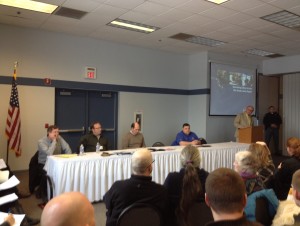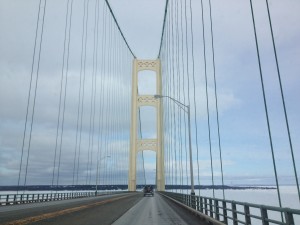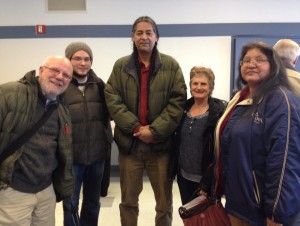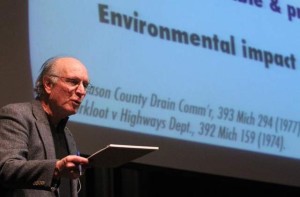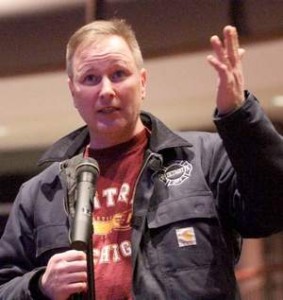
Pursuant to his recent publication in The Vermont Journal of Environmental Law, the following are some thoughts from Jim Olson on the importance of the public trust doctrine at this time in history.
Systemic Threats to Great Lakes Demand an Immediate Paradigm Shift to Water as Commons Protected By Public Trust
“We forget that the water cycle and the life cycle are one.” – Jack Cousteau
The systemic threats to the Great Lakes water, like the “dead zone” covering nearly one-third of western Lake Erie, with alarming algal blooms extending along the bays and shores of Lake Michigan, call for immediate action by state governments. That action is demanded by the public trust doctrine.
This ancient legal principle is alive and well in the Great Lakes, and places a fiduciary duty on states to prevent subordination or impairment of the public rights of use and enjoyment of these waters, and the waters and ecosystem that support them.
The states have been called the “sworn guardians” of this trust in the same way a bank trustee is accountable to its beneficiaries. If we demand and act to assure the integrity of these waters using the public trust principle as the benchmark, we will start making the right decisions about water, energy, food, transportation, and communities.
It’s a threatening time with the Great Lakes facing a critical mass of issues such as algal blooms, invasive species like Asian Carp, sewage overflows, threatened diversions, climate change and extreme water levels, overuse and waste from such water-intensive uses as crops, fracking, or poor urban infrastructure. But is an exciting time, with an open slate of new choices for our communities, businesses, farming and food, careers and jobs, transportation, and economy. In this century the public trust principles offer a unifying pathway or beacon to help us get there.
More and more biologists, hydrologists, and other scientists have documented that the billions of dollars spent worldwide in the past several decades to protect crucial conservation lands, international and national parks, wilderness, and biologically significant areas may be futile. The data shows all of the Earth’s natural systems are decline, despite our best efforts. This is because pollution, waste, and the effects of globally harmful practices like climate change or the release of hazardous substances do not know political or legal boundaries.
It is also because these larger systemic or massive harms have overwhelmed not only water and ecosystems but our twentieth century legal framework. Regulation by permit for every drop that is discharged to a sediment basin, treatment plant, lake or stream may have worked for specific place at a given time. But the fact is that these regulations have legalized lesser amounts of pollution or higher amounts of water losses and waste than watersheds and larger ecosystems like the Great Lakes can withstand.
For example, the International Joint Commission has documented and called for adaptive management practices to respond to the extreme changes in water level caused by climate change. Scientists, including those studying global warming, ice cover, precipitation, and evaporation, have documented that climate change is resulting in droughts with exponentially harmful effects on water levels and impacts on wetlands, streams, lakes, biological systems, fish, and habitat. Data shows a direct connection between the “dead zone” caused by non-point run off of phosphorous and nutrients into Lake Erie. The phosphorous combined with warmer water temperatures, clearer water from invasive species, to produce a toxic algal bloom covering nearly one-third of Lake Erie, closing beaches, killing fish, damaging fisheries, swimming, boating and recreation. These same blooms have been showing up in Michigan’s Saginaw Bay and Wisconsin’s Green Bay. Then there are the quagga mussels and hundreds of other invasive species, including the threat of Asian Carp that would alter and potentially wipe out a billion dollar fishery in the Great Lakes.
“Extreme energy” – massive, intensive, unconventional desecration of water, nature, and communities – is another example. As the global water crisis and droughts around the North America and the world intensify, there will be increasing demand to force water out of the Great Lakes basin to the southwest, the oil and gas development fields in the west, or to grow crops here to export food to drought or water-poor countries like China and the Middle East – so-called “virtual water.” Demands for diversions and exports of food and water will run up against demands for water for industries, food, urban areas, and recreation – all the backbone of our economy.
A dramatic example is the unfolding drama over the expanding use of pipelines and shipments of oil and natural gas from the Alberta tar sands and North Dakota heavy oil and natural gas through and over the Great Lakes region. Canada proposes two double the volume of tar sands oil the Alberta Clipper – Line 67 – will transport to Superior, Wisconsin on Lake Superior. From there a much dirtier, heavier oil with bitumen may be transported through Line 5 across Michigan’s Upper Peninsula, under the Mackinac Straits of Lake Huron and Lake Michigan, down through Michigan and under the St. Clair River to Sarnia. A spill under the best response conditions would cover 25 square miles of the Straits area. A spill from a ship carrying heavy oil would have equally decimating impacts.
So what framework and legal principles will work to save the Great Lakes and the rights and interests of the 40 million people who live around the largest freshwater surface water system in the world – 20 percent of the world’s fresh surface water? The public trust doctrine and its set of discrete principles that have protected water from private control and abuse for over 1,500 years.
- Public trust waters cannot be subordinated or transferred to the primary or exclusive control of private interests and gain.
- Public trust waters and the right of public use and enjoyment cannot be significantly impaired from one generation to the next.
- The states and provinces of Canada have a fiduciary duty to account to and assure their citizens that principles 1 and 2 have not and will not be violated.
These are the benchmarks for everything we face and how we should decide what is acceptable and what is not in terms of living up to the public trust doctrine. What’s been hard for sometime, that is until these recent systemic threats, is to understand that these waters and their management by states as trustees are commons, not private property. Markets and concepts of private property apply to private things. Public trust principles apply to common public things. It’s that simple. If we take to understand what is happening, and apply these benchmarks, we, our children and grandchildren will share in the same enjoyment and as we have in these waters held and managed under a solemn perpetual trust.
If you want to read about the history and principles under the public trust doctrine that apply to the Great Lakes basin in the U.S. and Canada, read the article in full, click here, or for reprints or hard copies of the article, contact Vermont Journal of Environmental Law editor Emily Remmel or visit vjel.vermontlaw.edu.
For more, read the press release here.
Postscript
As Maude Barlow puts it in her new book Blue Future: Protecting the Planet for People and the Planet Forever (The New Press 2013), “Olson writes in the Vermont Journal of Environmental Law, ‘a possible answer is the immediate adoption of a new narrative, with principles grounded in science, values, and policy, that views the systemic threats we face as part of the single connected hydrological whole, a commons governed by public trust principles.’ He goes on to say: ‘[t]he public trust is necessary to solve these threats that directly impact traditional public trust resources. The most obvious whole is not a construct of the mind, but the one in which we live – the hydrosphere, basin, and watersheds through which water flows, evaporates, transpires, is used, transferred, and is discharged [and recharged] in a continuous cycle. Every arc of the water cycle flows through and is affected by everything else, reminiscent of what Jacques Cousteau once said, ‘We forget that the water cycle and the life cycle are one.'”








